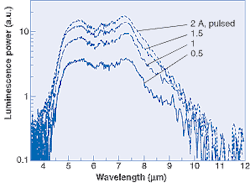
Creating semiconductor lasers that emit over a broad range of wavelengths is a challenge; attempts have been numerous and fraught with limitations. Recently, scientists at Lucent Technologies' Bell Laboratories (Murray Hill, NJ) have thwarted the mechanism behind conventional single-wavelength lasing to create a supercontinuum semiconductor laser that operates in the 5- to 8-μm wavelength range.1 Such an ultrabroadband laser has far-reaching implications for applications such as terabit optical data communications, ultraprecision metrology, and spectroscopy.
To achieve sustained supercontinuum generation, Claire Gmachl and collaborators adopted a quantum-cascade configuration, which tailors the quantum design of intersubband (IS) transitions via hundreds of thin semiconductor layers of varying thicknesses and positions in the stack. The IS optical transitions allow a Fabry-Perot spectrum to emerge continuously at all wavelengths from 6 to 8 μm.
The tiny lasers were grown using molecular beam epitaxy on an indium phosphide substrate, which acted as the bottom waveguide cladding. A 600-nm-thick indium gallium arsenide (InGaAs) layer followed, and then 36 layered IS active regions interleaved with injector regions. Another 400-nm-wide InGaAs layer finishes the core of the waveguide. The lasers were cleaved to lengths between 1.5 to 3 mm and etched with 130-μm-diameter mesas.
The lasers were operated at various temperatures in continuous-wave mode and in pulses of 50- to 100-ns duration at a rate of up to 160 kHz. The spectra were generated using a Fourier-transform infrared spectrometer and detected using a cooled mercury cadmium telluride (HgCdTe) photocurrent detector. A fast room-temperature HgCdTe photovoltaic detector measured light output vs. current. The varying sensitivity of the HgCdTe photovoltaic detector was calibrated using a wavelength-independent thermopile laser-power meter.
Lasing occurred first around a 7.3-μm wavelength region at a peak current of 1.07 A. As the current was increased, a broader Fabry-Perot spectrum emerged from 6 to 7.6 μm at 5 A; 6- to 8-μm lasing was established at 8 A. The pattern of lasing was extremely repeatable in various devices, reports the team, and observable up to room temperature (see figure).
The importance of these results is not simply the supercontinuum nature of the laser, but the design flexibility.
"On one hand," says Gmachl, "the work shows a new path to extremely broad spectral-range lasers with important applications such as ultrawide tunable sources in sensitive absorption spectroscopy, while keeping the advantages of the compact, rugged semiconductor-device approach. On the other hand, it opens up a new field for quantum-cascade lasers. By designing heterogeneous cascades, the lasers can accomplish many more things than a homogeneous cascade laser ever could."
Other possibilities include numerous types of custom-tailored light sources for applications such as biological specimens with complex optical responses, or trace-gas sensors. Using modelocking, such a source could be designed for use in time-resolved spectroscopy in the mid-infrared. It may also be possible, say the researchers, to apply the technology to fiberoptic applications for use in optical data communications.
REFERENCE
1. C. Gmachl et al., Nature 415, 883 (Feb. 21, 2002).
About the Author
Valerie Coffey-Rosich
Contributing Editor
Valerie Coffey-Rosich is a freelance science and technology writer and editor and a contributing editor for Laser Focus World; she previously served as an Associate Technical Editor (2000-2003) and a Senior Technical Editor (2007-2008) for Laser Focus World.
Valerie holds a BS in physics from the University of Nevada, Reno, and an MA in astronomy from Boston University. She specializes in editing and writing about optics, photonics, astronomy, and physics in academic, reference, and business-to-business publications. In addition to Laser Focus World, her work has appeared online and in print for clients such as the American Institute of Physics, American Heritage Dictionary, BioPhotonics, Encyclopedia Britannica, EuroPhotonics, the Optical Society of America, Photonics Focus, Photonics Spectra, Sky & Telescope, and many others. She is based in Palm Springs, California.
